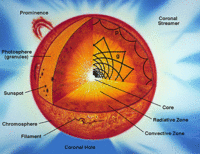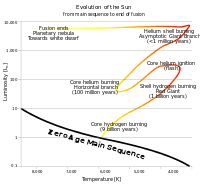Stars/Sun/Standard models
< Stars < Sun
The Standard Solar Model is the currently popular model for the Sun.
Protons

The following fusion reaction produces neutrinos and accompanying gamma-rays of the energy indicated:
Observation of gamma rays of this energy likely indicate this reaction is occurring nearby.
"In ... the Cowan–Reines neutrino experiment, antineutrinos created in a nuclear reactor by beta decay reacted with protons producing neutrons and positrons:"[1]
- ν
e + p+
→ n0
+ e+
"The positron quickly finds an electron, and they annihilate each other. The two resulting gamma rays (γ) [511 keV each] are detectable. The neutron can be detected by its capture on an appropriate nucleus, releasing a gamma ray. The coincidence of both events – positron annihilation and neutron capture – gives a unique signature of an antineutrino interaction."[1]
"It is fair to note, however, that almost all theories which invoke non-baryonic matter require some level of coincidence in order that the luminous and unseen mass contribute comparable densities (to within one or two powers often). For instance, in a neutrino-dominated universe, (mv/mproton) must be within a factor ~ 10 of nb/nγ. The only model that seems to evade this requirement is Witten’s (1984) idea that the quark-hadron phase transition may leave comparable amounts of material in ‘ordinary’ baryons and in ‘nuggets’ of exotic matter."[2]
Neutrinos

"A star is considered to be at zero age (protostellar) when it is assumed to have a homogeneous composition and to be just beginning to derive most of its luminosity from nuclear reactions (so neglecting the period of contraction from a cloud of gas and dust). To obtain the SSM, a one solar mass stellar model at zero age is evolved numerically to the age of the Sun. The abundance of elements in the zero age solar model is estimated from primordial meteorites.[3] Along with this abundance information, a reasonable guess at the zero-age luminosity (such as the present-day Sun's luminosity) is then converted by an iterative procedure into the correct value for the model, and the temperature, pressure and density throughout the model calculated by solving the equations of stellar structure numerically assuming the star to be in a steady state. The model is then evolved numerically up to the age of the Sun. Any discrepancy from the measured values of the Sun's luminosity, surface abundances, etc. can then be used to refine the model. For example, since the Sun formed, the helium and heavy elements have settled out of the photosphere by diffusion. As a result, the Solar photosphere now contains about 87% as much helium and heavy elements as the protostellar photosphere had; the protostellar Solar photosphere was 71.1% hydrogen, 27.4% helium, and 1.5% metals.[3] A measure of heavy-element settling by diffusion is required for a more accurate model."[4]
"Nuclear reactions in the core of the Sun change its composition, by converting hydrogen nuclei into helium nuclei by the proton-proton chain and (to a lesser extent in the Sun than in more massive stars) the CNO cycle. This decreases the mean molecular weight in the core of the Sun, which should lead to a decrease in pressure. This does not happen as instead the core contracts. By the Virial Theorem half of the gravitational potential energy released by this contraction goes towards raising the temperature of the core, and the other half is radiated away. By the ideal gas law this increase in temperature also increases the pressure and restores the balance of hydrostatic equilibrium. The luminosity of the Sun is increased by the temperature rise, increasing the rate of nuclear reactions. The outer layers expand to compensate for the increased temperature and pressure gradients, so the radius also increases.[5]"[4]
"Most of the neutrinos produced in the sun come from the first step of the pp chain but their energy is so low (<0.425 MeV)[6] they are very difficult to detect. A rare side branch of the pp chain produces the "boron-8" neutrinos with a maximum energy of roughly 15 MeV, and these are the easiest neutrinos to detect. A very rare interaction in the pp chain produces the "hep" neutrinos, the highest energy neutrinos predicted to be produced by our sun. They are predicted to have a maximum energy of about 18 MeV."[4]
"All of the interactions described above produce neutrinos with a spectrum of energies. The electron capture of 7Be produces neutrinos at either roughly 0.862 MeV (~90%) or 0.384 MeV (~10%).[6]"[4]
Sun
"The Standard Solar Model (SSM) refers to a mathematical treatment of the Sun as a spherical ball of gas (in varying states of ionisation, with the hydrogen in the deep interior being a completely ionised plasma). This model, technically the spherically symmetric quasi-static model of a star, has stellar structure described by several differential equations derived from basic physical principles. The model is constrained by boundary conditions, namely the luminosity, radius, age and composition of the Sun, which are well determined. The age of the Sun cannot be measured directly; one way to estimate it is from the age of the oldest meteorites, and models of the evolution of the solar system.[7] The composition in the photosphere of the modern-day Sun, by mass, is 74.9% hydrogen and 23.8% helium.[3] All heavier elements, called metals in astronomy, account for less than 2 percent of the mass. The SSM is used to test the validity of stellar evolution theory. In fact, the only way to determine the two free parameters of the stellar evolution model, the helium abundance and the mixing length parameter (used to model convection in the Sun), are to adjust the SSM to "fit" the observed Sun."[4]
"The differential equations of stellar structure, such as the equation of hydrostatic equilibrium, are integrated numerically. The differential equations are approximated by difference equations. The star is imagined to be made up of spherically symmetric shells and the numerical integration carried out in finite steps making use of the equations of state, giving relationships for the pressure, the opacity and the energy generation rate in terms of the density, temperature and composition.[5]"[4]
Sun

The current evolutionary model for the fusion-burning lifetime of the Sun is diagrammed at right.
Research
Hypothesis:
- A standard solar model encompassing electron-beam heating may be necessary.
Control groups

The findings demonstrate a statistically systematic change from the status quo or the control group.
“In the design of experiments, treatments [or special properties or characteristics] are applied to [or observed in] experimental units in the treatment group(s).[8] In comparative experiments, members of the complementary group, the control group, receive either no treatment or a standard treatment.[9]"[10]
Proof of concept
Def. a “short and/or incomplete realization of a certain method or idea to demonstrate its feasibility"[11] is called a proof of concept.
Def. evidence that demonstrates that a concept is possible is called proof of concept.
The proof-of-concept structure consists of
- background,
- procedures,
- findings, and
- interpretation.[12]
See also
References
- 1 2 "Neutrino, In: Wikipedia". San Francisco, California: Wikimedia Foundation, Inc. May 8, 2013. Retrieved 2013-05-08.
- ↑ Martin J. Rees (December 1984). "Is the Universe flat?". Journal of Astrophysics and Astronomy 5 (4): 331-48. http://link.springer.com/article/10.1007/BF02714464. Retrieved 2013-12-18.
- 1 2 3 Lodders, K. (2003). "Abundances and Condensation Temperatures of the Elements". Meteoritics & Planetary Science 38 (suppl.): 5272. doi:10.1086/375492. http://www.lpi.usra.edu/meetings/metsoc2003/pdf/5272.pdf.
- 1 2 3 4 5 6 "Standard solar model, In: Wikipedia". San Francisco, California: Wikimedia Foundation, Inc. August 17, 2012. Retrieved 2012-11-23.
- 1 2 Ostlie, Dale A. and Carrol, Bradley W., An introduction to Modern Stellar Astrophysics, Addison-Wesley (2007)
- 1 2 Bahcall, John. "Solar Neutrino Viewgraphs". Institute for Advanced Study School of Natural Science. Retrieved 2006-07-11.
- ↑ Guenther, D.B. (April 1989). "Age of the sun". Astrophysical Journal 339: 1156–1159. doi:10.1086/167370.
- ↑ Klaus Hinkelmann, Oscar Kempthorne (2008). Design and Analysis of Experiments, Volume I: Introduction to Experimental Design (2nd ed.). Wiley. ISBN 978-0-471-72756-9. http://books.google.com/?id=T3wWj2kVYZgC&printsec=frontcover.
- ↑ R. A. Bailey (2008). Design of comparative experiments. Cambridge University Press. ISBN 978-0-521-68357-9. http://www.cambridge.org/uk/catalogue/catalogue.asp?isbn=9780521683579.
- ↑ "Treatment and control groups, In: Wikipedia". San Francisco, California: Wikimedia Foundation, Inc. May 18, 2012. Retrieved 2012-05-31.
- ↑ "proof of concept, In: Wiktionary". San Francisco, California: Wikimedia Foundation, Inc. November 10, 2012. Retrieved 2013-01-13.
- ↑ Ginger Lehrman and Ian B Hogue, Sarah Palmer, Cheryl Jennings, Celsa A Spina, Ann Wiegand, Alan L Landay, Robert W Coombs, Douglas D Richman, John W Mellors, John M Coffin, Ronald J Bosch, David M Margolis (August 13, 2005). "Depletion of latent HIV-1 infection in vivo: a proof-of-concept study". Lancet 366 (9485): 549-55. doi:10.1016/S0140-6736(05)67098-5. http://www.ncbi.nlm.nih.gov/pmc/articles/PMC1894952/. Retrieved 2012-05-09.
External links
- African Journals Online
- Bing Advanced search
- Google Books
- Google scholar Advanced Scholar Search
- International Astronomical Union
- JSTOR
- Lycos search
- NASA/IPAC Extragalactic Database - NED
- NASA's National Space Science Data Center
- Office of Scientific & Technical Information
- Questia - The Online Library of Books and Journals
- SAGE journals online
- The SAO/NASA Astrophysics Data System
- Scirus for scientific information only advanced search
- SDSS Quick Look tool: SkyServer
- SIMBAD Astronomical Database
- SIMBAD Web interface, Harvard alternate
- Spacecraft Query at NASA.
- SpringerLink
- Taylor & Francis Online
- Universal coordinate converter
- Wiley Online Library Advanced Search
- Yahoo Advanced Web Search
| ||||||||||||||||||||||||||||||||||||||
![]() This is a research project at http://en.wikiversity.org
This is a research project at http://en.wikiversity.org
| |
Development status: this resource is experimental in nature. |
| |
Educational level: this is a research resource. |
| |
Resource type: this resource is an article. |
| |
Resource type: this resource contains a lecture or lecture notes. |
| |
Subject classification: this is an astrophysics resource. |
